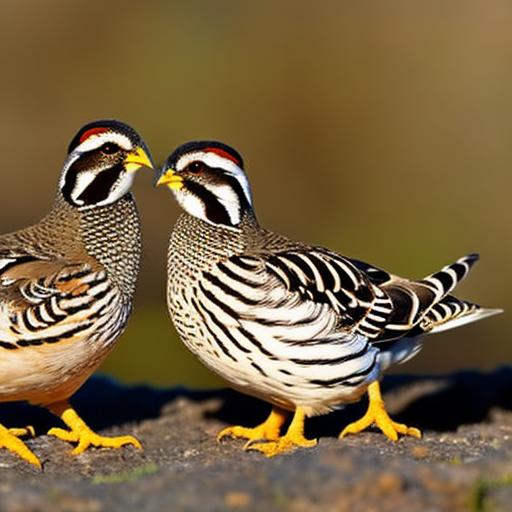Quails are small, ground-dwelling birds that are known for their social nature. They are highly sociable birds and are often found in groups called coveys. In the wild, quails live in close-knit communities and rely on each other for protection and companionship. They are also known for their territorial behavior, especially during the breeding season when males can become aggressive towards each other to establish dominance and attract mates.
Quails are also known for their vocalizations, which they use to communicate with each other. They have a variety of calls that they use to signal danger, attract mates, and maintain contact with their group. Understanding quail behavior is essential for keeping them in captivity, as it helps to create a suitable living environment and manage their social dynamics effectively.
Key Takeaways
- Quail are social birds that thrive in pairs or small groups
- Keeping two male quails together can lead to aggression and fighting
- A suitable living environment for two male quails should include separate hiding spots and plenty of space
- Introducing two male quails should be done gradually and in a neutral territory
- Aggression between male quails can be managed by providing enough space and distractions
- Signs of stress or aggression in quails include feather plucking and excessive vocalization
- Seek professional advice if aggression between male quails persists or escalates
Challenges of Keeping Two Male Quails Together
Keeping two male quails together can be challenging due to their natural territorial and aggressive behavior, especially during the breeding season. Male quails can become aggressive towards each other when they are competing for mates or establishing dominance within their living environment. This aggression can lead to fighting, injuries, and even death if not managed properly.
In captivity, keeping two male quails together requires careful observation and management to prevent aggression and ensure their well-being. It is essential to provide enough space, hiding spots, and resources to minimize competition and reduce the likelihood of conflict between the two males. Additionally, understanding their social dynamics and behavior can help in creating a suitable living environment and preventing potential challenges of keeping two male quails together.
Creating a Suitable Living Environment for Two Male Quails
Creating a suitable living environment for two male quails involves providing enough space, shelter, and resources to accommodate their natural behavior and social dynamics. Quails require a spacious enclosure with plenty of room to move around and establish their territories without feeling crowded or threatened by each other. Providing hiding spots such as plants, logs, or shelters can help quails to retreat and avoid potential conflicts when needed.
In addition to space and shelter, it is essential to provide multiple feeding and watering stations to minimize competition for resources. This can help reduce the likelihood of aggression between the two male quails and ensure that they have access to food and water without feeling the need to compete with each other. Creating a suitable living environment for two male quails also involves providing a balanced diet, suitable substrate for scratching and dust bathing, and appropriate lighting and temperature to support their overall well-being.
Introducing Two Male Quails
Introducing two male quails requires careful planning and observation to minimize potential aggression and ensure a smooth transition into their new living environment. It is essential to introduce the two males in a neutral territory where neither of them has established dominance or territorial behavior. This can help reduce the likelihood of conflict and aggression during the introduction process.
When introducing two male quails, it is important to monitor their behavior closely and be prepared to separate them if any signs of aggression or stress are observed. Providing enough space, hiding spots, and resources during the introduction process can help minimize competition and reduce the likelihood of conflict between the two males. It is also important to introduce them gradually and monitor their interactions to ensure that they are able to coexist peacefully in their new living environment.
Monitoring and Managing Aggression
Monitoring and managing aggression between two male quails involves careful observation, understanding their behavior, and taking proactive measures to prevent potential conflicts. It is important to monitor their interactions closely and be prepared to intervene if any signs of aggression or stress are observed. This can include separating the two males temporarily or providing additional hiding spots and resources to minimize competition.
Managing aggression between two male quails also involves providing enough space and enrichment to keep them occupied and reduce the likelihood of conflict. This can include providing toys, perches, and other forms of environmental enrichment to keep them mentally stimulated and prevent boredom or frustration that can lead to aggression. Additionally, providing a balanced diet and ensuring that their nutritional needs are met can help reduce stress and prevent potential conflicts between the two males.
Signs of Stress or Aggression

Signs of stress or aggression in two male quails can include aggressive behavior such as pecking, chasing, or fighting, as well as changes in vocalizations or body language. It is important to monitor their behavior closely and be aware of any changes that may indicate potential stress or aggression. This can include changes in their eating or drinking habits, changes in their vocalizations, or changes in their overall activity level.
Other signs of stress or aggression in two male quails can include feather plucking, pacing, or hiding, as well as changes in their posture or body language. It is important to be observant and proactive in addressing any signs of stress or aggression to prevent potential conflicts and ensure the well-being of the two males. Seeking professional advice from a veterinarian or avian behavior specialist can also be helpful in identifying and addressing any signs of stress or aggression in two male quails.
Seeking Professional Advice
Seeking professional advice from a veterinarian or avian behavior specialist can be beneficial in managing the behavior and social dynamics of two male quails. These professionals can provide valuable insights into understanding quail behavior, identifying signs of stress or aggression, and implementing effective management strategies to ensure the well-being of the two males. They can also provide guidance on creating a suitable living environment, introducing two male quails, and monitoring and managing aggression effectively.
In addition to seeking professional advice, it is important for quail owners to stay informed about best practices for keeping quails in captivity and managing their social dynamics. This can include staying updated on current research and resources related to quail behavior, seeking advice from experienced quail owners or breeders, and being proactive in addressing any challenges or concerns related to keeping two male quails together. By staying informed and seeking professional advice when needed, quail owners can ensure the well-being of their birds and create a harmonious living environment for two male quails.
If you’re considering keeping two male quails together, it’s important to understand their social dynamics and potential challenges. According to a related article on PoultryWizard, understanding the behavior of your quails is crucial for their well-being. The article provides valuable insights into the social structure of quails and offers tips for creating a harmonious environment for them. For more information, you can check out the article here.
FAQs
Can you keep two male quails together?
Yes, it is possible to keep two male quails together in the same enclosure.
Are there any special considerations when keeping two male quails together?
It is important to provide enough space for the quails to establish their own territories and minimize aggression. Providing hiding spots and multiple feeding and watering stations can help reduce conflict.
What are the signs of aggression between male quails?
Signs of aggression between male quails can include pecking, chasing, and vocalizations such as loud calling or crowing.
What can be done to reduce aggression between male quails?
Providing a larger enclosure, offering hiding spots, and ensuring there are multiple food and water sources can help reduce aggression between male quails. If aggression persists, separating the quails may be necessary.
Are there any specific breeds of quails that are more or less aggressive towards each other?
Some quail breeds may be more or less aggressive towards each other, but individual temperament can also play a role. It is important to monitor the behavior of the quails and make adjustments as needed.
Meet Walter, the feathered-friend fanatic of Florida! Nestled in the sunshine state, Walter struts through life with his feathered companions, clucking his way to happiness. With a coop that’s fancier than a five-star hotel, he’s the Don Juan of the chicken world. When he’s not teaching his hens to do the cha-cha, you’ll find him in a heated debate with his prized rooster, Sir Clucks-a-Lot. Walter’s poultry passion is no yolk; he’s the sunny-side-up guy you never knew you needed in your flock of friends!







